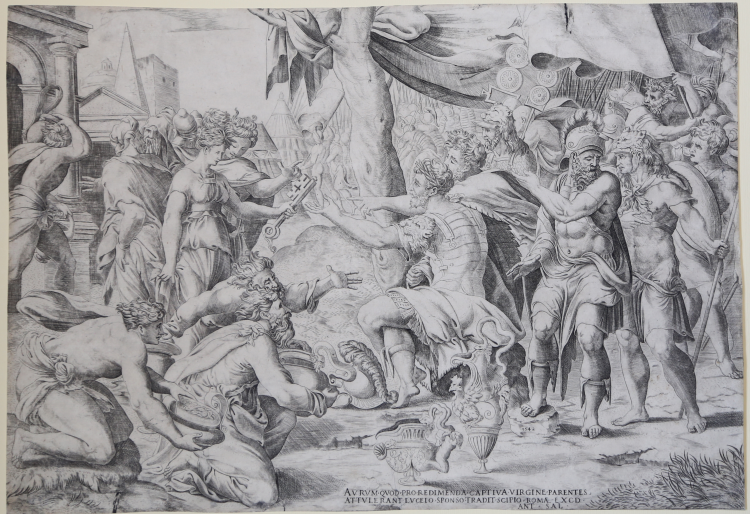



| Reference: | s31782 |
| Author | Enea VICO |
| Year: | 1542 |
| Measures: | 431 x 297 mm |


| Reference: | s31782 |
| Author | Enea VICO |
| Year: | 1542 |
| Measures: | 431 x 297 mm |
Engraving, 1542, inscribed lower right, including publisher's address: 'AVRVM QVOD PRO REDIMENDA CAPTIVA VIRGINE PARENTES/ATTVLERANT LVCEIO SPONSO TRADIT SCIPIO ROMAE EXCD/ANT. SAL.' , dated '1542'. After a subject attributed to Salviati.
Example of the first state of three, with the address of Antonio Salamanca. A good impression, printed on contemporary laid paper with "eagle in a circle with crown" watermark, trimmed to the borderline, good condition.
Cirillo Archer in TIB claims the burin work is close to Nicolas Beatrizet's Death of Meleager. Hermann Voss in 'Kompositionen des Francesco Salviati in der italienischen Graphik des XVI. Jahrhunderts', Beilage der Graphischen Künste 1 (1912), pp. 30-37, 60-70 ascribed the design to Salviati and attributed the print to the circle of Beatrizet. Bruce Davis attributed the engraving to Beatrizet himself. Most recently, under inv. no. 1859,0806.312 the British Museum database attributed the engraving to Enea Vico by demonstrating it has a similar size and technique to Vico's Battle of the Lapiths and Centaurs made in the same year, when Salamanca published a number of Vico's prints and none by Beatrizet.
An attibution to Vico was proposed in the 'Notice des fayences peintres italiennes. . .,' Series G, published by Charles de Mourgues Freres, 1864 (Oxford edition) where the author describes a 1542 engraving published by Antonio Salamanca of 'The Continence of Scipio' and says that if Vico was not the engraver, he was certainly the model for the engraver. The influence of Veneziano has also been noted.Vico seems to have chosen to imitate certain devices that are particular to Veneziano. The obelisk that appears to the left in the 'Scipio' engraving was used in Veneziano's engravings, 'The Death of Ananias' (B.xiv.47.42. BM.1869,0410.154) and 'Camillus Entering the City' (B.xiv.164201. BM. H,7.21). The use of the obelisk as an architectural device cannot be seen in other engravers' prints executed in Rome during this time. The obelisk reappears again in three plates of the 'Fable of Psyche' series that Veneziano collaborated with the Master of the Die in executing. It also reappears again in another Enea Vico print, 'St.George and the Dragon' Bartsch XV.30.3 (as School of Marcantonio Raimondi after a Florentine artist, close to the manner of Agostino de Musi).
The episode depicted is related by Livy (XXVI,5): the Roman general Scipio Africanus, after the defeat of Carthage was offered a beautiful woman called Lucretia as his captive. But when he was told of her betrothal to the Carthaginian Allucius, Scipio nobly returned Lucretia to him and returned the gold sent as ransom by her parents.
Bibliografia
Passavant VI.82.56; Massari, Giulio Romano Pinxit ed delineavit, no. 68; Cirillo Archer, in TIB 1995, 2801.032.S1; Le Blanc III.283.39; Bruce Davis, Mannerist Prints…exhibition catalogue, no. 8; British Museum, inv. n. 1859,0806.312.
Enea VICO (Parma 1523 - Ferrara 1567)
|
Enea, son of Francesco, was antique dealer, drawer, engraver and numismatist. He was born in Parma on January 29th, 1523, according to what Huber says. After the first school years in the city, and very likely after he made acquaintance with the works of Giulio Romano, Vico moved to Rome in 1541. He then worked for Tommaso Barlacchi, who also engraved with him a series of Grottesche, in 1542. In the classical atmosphere of Rome, Vico’s style developed according to that of Perin del Vaga and Francesco Salviati, but always with Parmigianino as main reference. Around the first half of the century and after studying the works of Marcantonio, Agostino Veneziano, Caraglio and Bonasone, Vico acquired his own, peculiar style which can be seen in his main works. From Rome Vico moved to Florence, where he worked for Cosimo I, and then went to Venice, in 1557. In 1563 he is already in Ferrara, working for Alfonso d’Este till his death in 1567.
|
Enea VICO (Parma 1523 - Ferrara 1567)
|
Enea, son of Francesco, was antique dealer, drawer, engraver and numismatist. He was born in Parma on January 29th, 1523, according to what Huber says. After the first school years in the city, and very likely after he made acquaintance with the works of Giulio Romano, Vico moved to Rome in 1541. He then worked for Tommaso Barlacchi, who also engraved with him a series of Grottesche, in 1542. In the classical atmosphere of Rome, Vico’s style developed according to that of Perin del Vaga and Francesco Salviati, but always with Parmigianino as main reference. Around the first half of the century and after studying the works of Marcantonio, Agostino Veneziano, Caraglio and Bonasone, Vico acquired his own, peculiar style which can be seen in his main works. From Rome Vico moved to Florence, where he worked for Cosimo I, and then went to Venice, in 1557. In 1563 he is already in Ferrara, working for Alfonso d’Este till his death in 1567.
|